This post may contain affiliate links. If you click and buy, we may earn a small commission at no extra cost to you. Learn more.
The old mexican house aesthetic is truly a treasure. It combines traditional mexican house styles with historic charm. The colorful facades and detailed architecture make these homes warm and welcoming.
At the core of the traditional mexican house is a deep culture and heritage. This is seen in its old mexican house aesthetic. The use of natural materials like wood and stone adds warmth and character, making these homes special.
The traditional mexican house is more than a place to live. It’s an experience that takes you back in time. With its rich history, stunning architecture, and old mexican house aesthetic, it’s no wonder these homes inspire love worldwide.
Contents
- 1 The Rich Heritage of Old Mexican House Architecture
- 2 Essential Features of Traditional Mexican House Exteriors
- 3 The Magic of Adobe Construction in Mexican Homes
- 4 Vibrant Color Palettes That Define Mexican Architecture
- 5 Mexican Courtyards and Outdoor Living Spaces
- 6 Authentic Interior Elements of an Old Mexican House
- 7 Traditional Mexican Tile Work and Patterns
- 8 Wooden Features and Architectural Details
- 9 Room-by-Room Guide to Mexican Home Design
- 10 Modern Interpretations of Mexican House Style
- 11 Decorating Tips for Mexican-Inspired Homes
- 12 Conclusion: Embracing the Timeless Appeal of Mexican Architecture
The Rich Heritage of Old Mexican House Architecture
Old Mexican house style is a mix of different cultures, creating a unique and captivating design. The history of Mexican architecture is long and complex. It has many periods and styles that make up the rich heritage of old Mexican houses.
The exterior of old Mexican houses shows the country’s cultural diversity. Adobe construction is a traditional method that lasts for centuries. It keeps the house cool and strong. The vibrant colors and detailed designs on the facade make these houses charming.
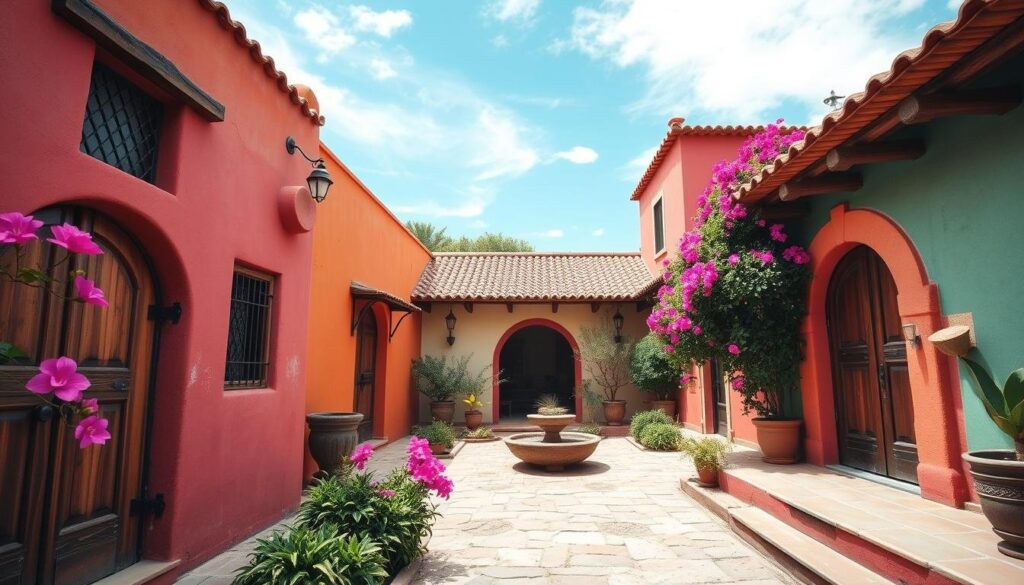
- Use of natural materials, such as adobe and wood
- Vibrant color schemes and detailed designs
- Large patios and outdoor living spaces
- Intricate tile work and ornate details
Origins and Historical Significance
The origins of old Mexican house architecture go back to before the Spanish arrived. The Mayans and Aztecs influenced it. The Spanish brought new styles, mixing indigenous and European influences.
Cultural Influences on Design
Cultural influences have shaped traditional Mexican houses. Bright colors, patterns, and details show the country’s rich heritage. They reflect the history of cultural exchange.
Essential Features of Traditional Mexican House Exteriors
The old mexican house aesthetic is known for its unique exterior features. These features add charm and functionality. Adobe, a natural material, is often used for walls. It insulates well and lasts long.
Adobe walls are then plastered and painted with bright colors. This makes the houses stand out even more.
Patios or courtyards are another key feature. These spaces are beautiful and serve as a place for family and friends to gather. They are decorated with traditional Mexican tiles, plants, and furniture.
This creates a warm and welcoming atmosphere. The patio connects indoor and outdoor living seamlessly.
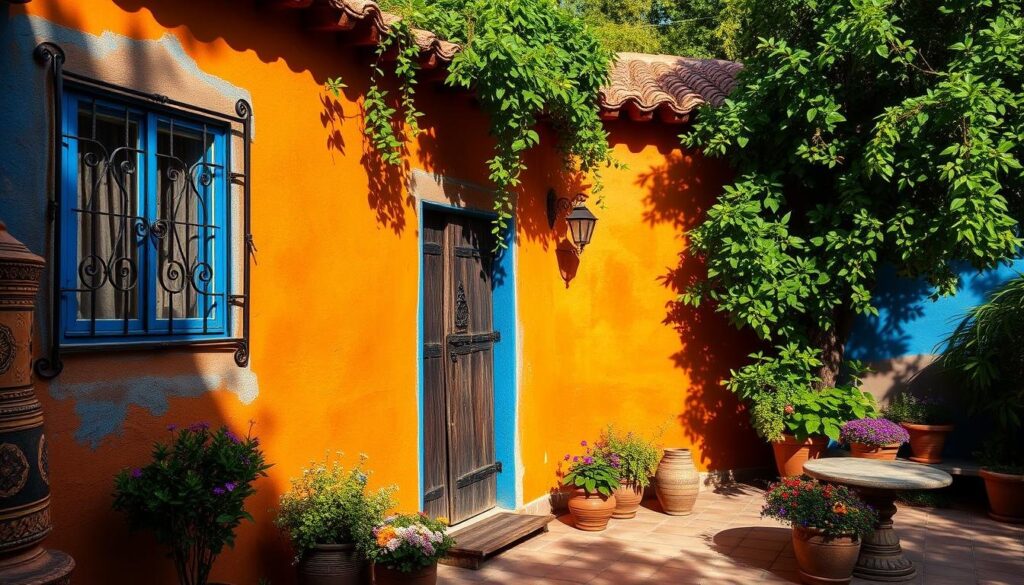
- Adobe construction
- Vibrant color palettes
- Patios and courtyards
- Traditional Mexican tiles and decorative elements
Together, these elements make the old mexican house aesthetic unique and beautiful.
The old mexican house aesthetic is a perfect blend of traditional and natural elements. It creates a unique and inviting exterior space that reflects the country’s rich cultural heritage.
The Magic of Adobe Construction in Mexican Homes
Adobe construction has been key in Mexican homes for centuries. It offers durability and beauty. Adobe homes stay cool in summer and warm in winter.
Adobe is mixed with other natural materials for strength and sustainability. This method makes traditional Mexican houses beautiful and eco-friendly.
Benefits of Adobe Buildings
- Energy efficiency: Adobe buildings keep temperatures steady, cutting down on heating and cooling needs.
- Sustainability: Adobe is natural and non-toxic, often sourced locally.
- Aesthetic appeal: Adobe adds a unique, traditional look to Mexican houses.
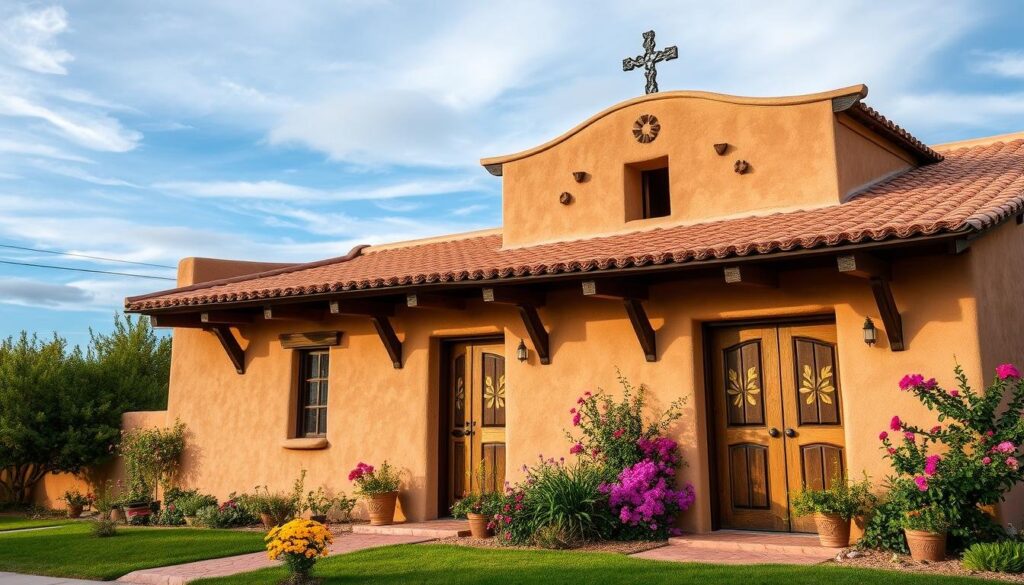
Traditional Construction Methods
Adobe is mixed with water and natural materials to make a building material. This mix is shaped into bricks or blocks for walls. The result is a strong, long-lasting home that needs little upkeep.
Today, adobe construction combines old charm with new tech. This mix creates unique, functional, and sustainable Mexican houses.
Vibrant Color Palettes That Define Mexican Architecture
Vibrant colors are key in old mexican house style. They show the country’s rich culture. From colonial blues and yellows to modern pinks and oranges, each color tells a story.
Choosing colors in old mexican house style is more than looks. It affects how people feel. Blue brings calm, while yellow brings joy. This helps create a balanced home.
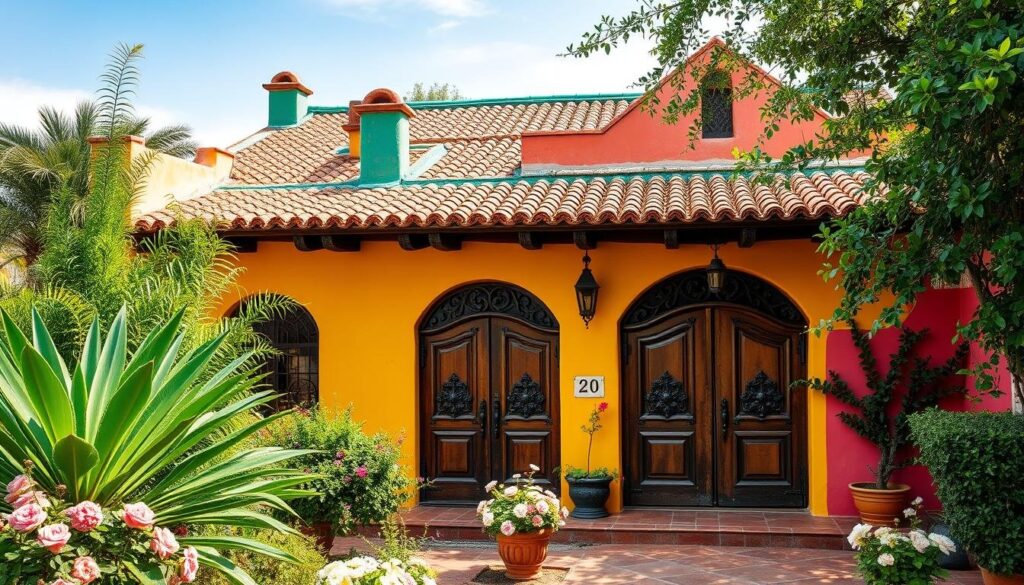
- Earth tones such as terracotta and sienna
- Bright colors like turquoise and coral
- Pastel shades such as pale pink and baby blue
These colors are mixed in creative ways. This makes homes uniquely Mexican. Embracing these colors adds warmth and personality to old mexican house style homes.
Mexican Courtyards and Outdoor Living Spaces
At the heart of an old mexican house aesthetic lies a serene and inviting outdoor space. Here, family and friends can gather to relax and socialize. The courtyard, or central patio, is a key feature of traditional Mexican homes. It provides a tranquil oasis from daily life’s hustle and bustle.
These outdoor living spaces are designed to blend with the surrounding architecture. This creates a harmonious balance between nature and structure. The old mexican house aesthetic uses natural materials like stone, wood, and clay in its courtyard design.
Central Patio Designs
A typical central patio has a large, open area surrounded by columns or arches. A fountain or water feature sits at its center. The sound of flowing water creates a soothing atmosphere, perfect for relaxation.
The patio is often decorated with vibrant flowers, shrubs, and trees. These add color and fragrance to the space.

Garden Elements and Features
Mexican courtyards also feature garden elements like walking paths, benches, and decorative planters. These elements create a sense of serenity and tranquility. They invite residents to spend time outdoors and connect with nature.
By incorporating these design elements, homeowners can create a stunning outdoor living space. Whether you’re looking to relax, entertain, or enjoy the fresh air, a well-designed Mexican courtyard is ideal.
Authentic Interior Elements of an Old Mexican House
Stepping into a traditional Mexican house is like entering a world of vibrant colors and rich textures. The interior design shows off Mexican heritage, making every space warm and inviting. You’ll see tiles, traditional furniture, and wood beams that make the house beautiful.
Some key elements in a traditional Mexican house include:
- Colorful tiles, often made from ceramic or clay, which add a pop of color to the space
- Traditional furniture, such as wooden benches and chairs, which are often adorned with intricat carvings
- Wood beams, which are used to support the structure of the house and add a touch of warmth to the interior
A traditional Mexican house is more than just a home. It’s a showcase of the country’s rich cultural heritage. The tiles, furniture, and wood beams all come together to make a space that feels uniquely Mexican. Exploring a traditional Mexican house lets you see the beauty and skill that goes into these elements.

In a traditional Mexican house, every detail is chosen with care. From the colorful tiles to the wooden furniture, each piece is picked for its beauty, usefulness, and cultural value. Whether you want to create a traditional Mexican-inspired home or just appreciate these elements, a traditional Mexican house will inspire and amaze you.
Traditional Mexican Tile Work and Patterns
In an old mexican house style, tile work and patterns are key. They add color, texture, and cultural value to spaces. Tiles in mexican architecture have a long history, passed down through generations.
Talavera tiles stand out for their detailed designs and bright colors. They are a hallmark of traditional mexican tile work.
Traditional mexican tile work and patterns have unique features:
- Geometric patterns, like chevrons and hexagons, are common in floor tiles.
- Floral motifs decorate walls.
- Intricate borders add elegance to spaces.
In an old mexican house, tile work and patterns are more than pretty. They hold cultural and historical importance. Tiles reflect Mexico’s rich heritage, with designs inspired by its indigenous and colonial past.
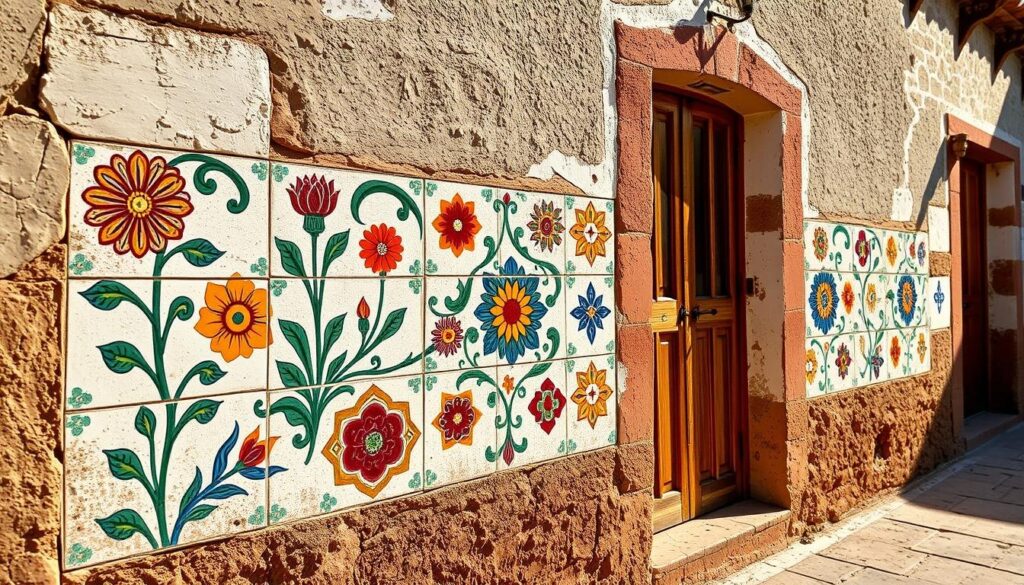
Using traditional mexican tile work and patterns in an old mexican house adds authenticity. It brings cultural significance to any room. Whether it’s Talavera tiles, geometric patterns, or floral motifs, they add color, texture, and personality.
Wooden Features and Architectural Details
The old mexican house aesthetic is all about natural materials, like wood. Wood beams, doors, and decorations make the inside and outside warm and full of character. It’s not just practical; it also makes the house look great.
In traditional Mexican homes, wood is used for intricate carvings and fancy details. This shows off Mexico’s rich culture. Wood is mixed with stone and clay to create a beautiful mix of textures and colors. This mix is what makes each old Mexican house special and unique.
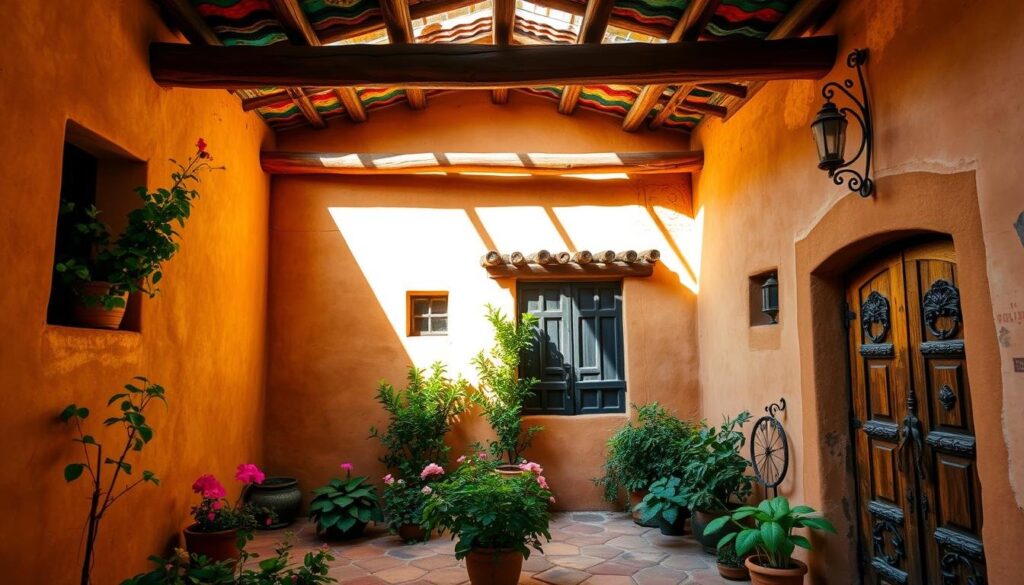
- Exposed wood beams, which add to the sense of openness and space
- Wooden doors, which are often adorned with intricate carvings and ornate details
- Decorative wooden elements, such as corbels and brackets, which add to the overall aesthetic appeal
These wooden features make the home beautiful and full of history. They give the old mexican house aesthetic a unique and special touch.
Room-by-Room Guide to Mexican Home Design
A traditional mexican house is known for its unique and functional design. It reflects the country’s rich cultural heritage. Each room is carefully planned to be both beautiful and functional.
In a traditional mexican house, the kitchen is often the heart of the home. It’s where family and friends gather to share meals and make memories. Some key features of a mexican kitchen include:
- Colorful tile work and decorative accents
- Large wooden tables and chairs
- Traditional cooking methods, such as clay ovens and grills
The living room is also an important space in a traditional mexican house. It’s designed to be comfortable and inviting. You’ll find:
- Plush furnishings and vibrant textiles
- Large windows and doors that open onto outdoor spaces
- Traditional mexican artwork and decorative elements

Each room in a traditional mexican house reflects the country’s unique cultural heritage. From the colorful tile work in the kitchen to the comfortable living spaces, these design elements are key. They help create a beautiful and functional traditional mexican house. It’s perfect for relaxing and entertaining.
Modern Interpretations of Mexican House Style
Modern architects and designers are reimagining old mexican house style. They mix traditional charm with today’s needs and looks. This has sparked a new wave of designs that are both classic and modern.
They use old materials in new ways. For instance, adobe construction makes modern, green homes. These homes are not only good for the planet but also look amazing. They also add vibrant color palettes and traditional mexican tile work to bring in authenticity.
Contemporary Adaptations
Some key modern changes include:
- Big windows and sliding doors for more light and openness
- Modern kitchens and bathrooms with talavera tiles and wooden accents
- Green materials and energy-saving systems to lessen environmental harm
Fusion Design Approaches
Fusion design blends traditional mexican style with other styles. This creates homes that stand out. It mixes old mexican design with modern, minimalist, or industrial styles.
By going for modern takes on old mexican house style, homeowners can have a space that’s both beautiful and practical. It also connects them to Mexico’s rich culture.
Decorating Tips for Mexican-Inspired Homes
To make your home feel like an old Mexican house, use traditional elements. Think about adding vibrant colors and wooden features to your modern space. Start with a bold color scheme, including turquoise, yellow, and orange. These colors are typical of Mexican architecture.
These colors can brighten up your walls, furniture, or accessories. They add a lively touch to your home.
Using natural materials like wood and stone is also key. Exposed wooden beams and stone floors bring warmth and texture. Traditional Mexican tiles, or talavera tiles, can also be used for backsplashes or countertops.
Don’t forget to add unique touches to your Mexican-inspired home. Consider vintage pottery, colorful textiles, and traditional artwork. These elements make your space both authentic and beautiful.
By following these decorating tips, you can create a Mexican-inspired home full of character. It’s perfect for anyone who loves the old Mexican house aesthetic.
Conclusion: Embracing the Timeless Appeal of Mexican Architecture
Exploring traditional Mexican houses and old styles shows their lasting charm. Their rich culture, detailed craftsmanship, and blend with nature are key. These homes truly show Mexico’s lively history, varied influences, and lasting traditions.
The beauty of Mexican architecture is undeniable. From the stunning adobe to the bright colors and welcoming outdoor areas, it’s a draw for many. By adding these elements to today’s homes, we can make spaces that are beautiful and deeply rooted in Mexican culture.
Starting your own journey into Mexican architecture’s beauty is exciting. It’s about respecting the past while enjoying the now. Celebrate the creativity, skill, and stories these homes share. Let them guide you to create spaces that stand out and are unforgettable.
To bring you cozy inspiration more efficiently, we sometimes use AI to assist in content creation — but every word and idea is carefully shaped by our team. See our AI Disclosure for more info.







